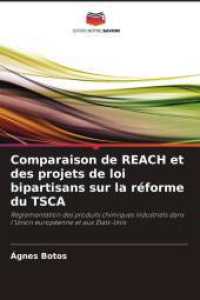- ホーム
- > 洋書
- > ドイツ書
- > Mathematics, Sciences & Technology
- > Earth Science
- > geology
Full Description
This textbook provides students and academics with a conceptual understanding of fire behavior and fire effects on people and ecosystems to support effective integrated fire management. Through case studies, interactive spreadsheets programmed with equations and graphics, and clear explanations, the book provides undergraduate, graduate, and professional readers with a straightforward learning path. The authors draw from years of experience in successfully teaching fundamental concepts and applications, synthesizing cutting-edge science, and applying lessons learned from fire practitioners.
We discuss fire as part of environmental and human health. Our process-based, comprehensive, and quantitative approach encompasses combustion and heat transfer, and fire effects on people, plants, soils, and animals in forest, grassland, and woodland ecosystems from around the Earth. Case studies and examples link fundamental concepts to local, landscape, and global fire implications, including social-ecological systems. Globally, fire science and integrated fire management have made major strides in the last few decades. Society faces numerous fire-related challenges, including the increasing occurrence of large fires that threaten people and property, smoke that poses a health hazard, and lengthening fire seasons worldwide. Fires are useful to suppress fires, conserve wildlife and habitat, enhance livestock grazing, manage fuels, and in ecological restoration. Understanding fire science is critical to forecasting the implication of global change for fires and their effects. Increasing the positive effects of fire (fuels reduction, enhanced habitat for many plants and animals, ecosystem services increased) while reducing the negative impacts of fires (loss of human lives, smoke and carbon emissions that threaten health, etc.) is part of making fires good servants rather than bad masters.
Contents
Part I: Introduction.- Part II: Combustion and Heat transfer processes.- Chapter 1: Ignition: Chemical Conditions.- Chapter 2: Chemical Processes: From Fuel to Smoke.- Chapter 3: Heat Production.-Chapter 4: Heat for pre-ignition and flames.-Chapter 5: Heat transfer.-Part III: Vegetation fuels, fire behavior and effects.-Chapter 6: Fuels and fire behavior description.-Chapter 7: Fire Propagation.-Chapter 8: Extreme Fire Behavior.- Chapter 9: Fire Effects on Plants, Soils and Animals.-Chapter 10: Fire and people.- Part IV: Managing fuels, fires and landscapes.- Chapter 11: Fuel dynamics and management.-Chapter 12: Fire regimes, landscape dynamics and landscape management.-Chapter 13: Integrated Fire Management.- Chapter 14: Futuring: Trends in Fire Science and Management.








